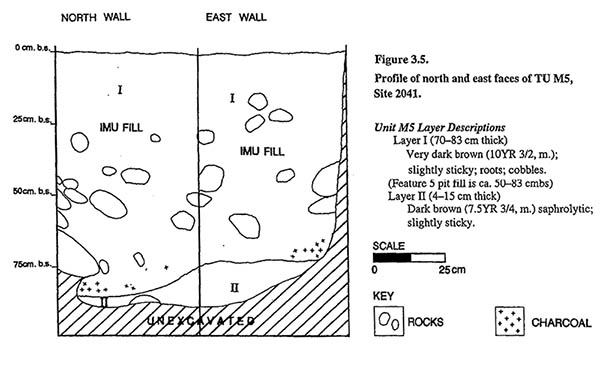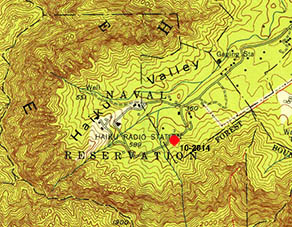|
Upland Imu:

Image from Williams and Nees (2002) archaeological study of Ha‘ikū Valley, showing one of the imu excavated.
Williams and Nees (2002) archaeological study of Ha‘ikū states as follows:
"The two subsurface imu (Features 4 and 5) appear to pre-date the construction and use of the terraces and pavement. They both date within a two hundred year span beginning in the mid-fifteenth century (ca. Cal. A.D. 1450-1680), and may represent cooking events that perhaps occurred as isolated events, with the Feature 4 imu likely reused on several occasions. Isolated imu are a common feature of windward inland areas in the Interstate Route H-3 corridor...."
“As H-3 was built through Ha‘ikū,” Lilikalā relates, “they started to dig from one side, and they started to dig from the other side—from Hālawa—and it didn’t meet. The workers would say there were all kinds of spooky things that happened there, like trucks that were parked with the key out would just start up and start moving by itself, or trucks might burst into fire all by itself, or they come in the morning and they would see footprints coming out of the tunnel that hadn’t been finished that had come overnight. So a lot of spirits there.

The location of site 10-2014.
“We’ll come to find out on the Hālawa side—Hālawa means ‘enough of breath—there were huge burials on that side, in the cliffs. When the Bishop Museum archaeologist went in up there, they found about 100 imu, earth ovens. What are these imu about? And the Bishop Museum guys said, ‘they were cooking ‘awa.’ You shouldn’t cook ‘awa in an imu.
“So then, ‘Oh, they were making pig.’ But nobody lived in the uplands, they lived by the shore. If you’re a pig hunter, you go kill a pig, you clean it, you bring it down to the shore, and you cook it by the shoreline. No, those imu were for taking the flesh off chiefly bodies. That whole area back there was dedicated to that. They would make a 10-day imu. They would let the flesh melt off the bone. They would put the bones into a casket, a sennit casket that they wove, and then they built a small temple to deify the chief. So now the chief is no longer an akua on the Earth, but akua in heavens. There’s all these remains of these small temples all throughout the area.”
|





